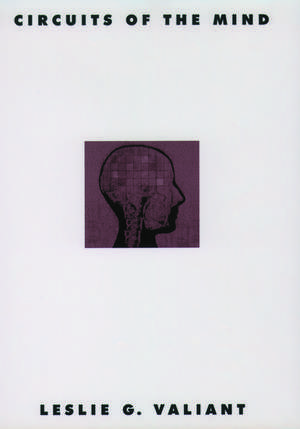Circuits of the Mind
Autor Leslie G. Valianten Limba Engleză Paperback – 11 ian 2001
| Toate formatele și edițiile | Preț | Express |
|---|---|---|
| Paperback (1) | 338.92 lei 32-37 zile | |
| Oxford University Press – 11 ian 2001 | 338.92 lei 32-37 zile | |
| Hardback (1) | 494.28 lei 32-37 zile | |
| Oxford University Press – 26 ian 1995 | 494.28 lei 32-37 zile |
Preț: 338.92 lei
Preț vechi: 370.70 lei
-9% Nou
Puncte Express: 508
Preț estimativ în valută:
64.85€ • 69.35$ • 54.07£
64.85€ • 69.35$ • 54.07£
Carte tipărită la comandă
Livrare economică 07-12 aprilie
Preluare comenzi: 021 569.72.76
Specificații
ISBN-13: 9780195126686
ISBN-10: 0195126688
Pagini: 256
Ilustrații: 1
Dimensiuni: 234 x 156 x 14 mm
Greutate: 0.36 kg
Ediția:Revised
Editura: Oxford University Press
Colecția OUP USA
Locul publicării:New York, United States
ISBN-10: 0195126688
Pagini: 256
Ilustrații: 1
Dimensiuni: 234 x 156 x 14 mm
Greutate: 0.36 kg
Ediția:Revised
Editura: Oxford University Press
Colecția OUP USA
Locul publicării:New York, United States
Recenzii
The book is written in a clear style, with a sufficient number of figures illustrating the algorithms. . .This new insight into complex problems of the brain, as well as the proposed methodology, makes the book highly readable and interesting.
The author shows that the proposed neuroidal model supports the cognitive activities he identifies. It provides a good structure to explore the functions of the mind still further.
Although there are many books today dealing with a simple neuronal model based on the weighted sum principle, this one rises above these others in providing an explanation of cognitive functions.
Delivers what its title promises, and more: an engaging, broad, thorough, and often deep, development of undergraduate complex analysis and related areas (non-Euclidean geometry, harmonic functions, etc.) from a geometric point of view. The style is lucid, informal, reader-friendly, and rich with helpful images (e.g., the complex derivative as an "amplitwist"). A truly unusual and notably creative look at a classical subject.
The author shows that the proposed neuroidal model supports the cognitive activities he identifies. It provides a good structure to explore the functions of the mind still further.
Although there are many books today dealing with a simple neuronal model based on the weighted sum principle, this one rises above these others in providing an explanation of cognitive functions.
Delivers what its title promises, and more: an engaging, broad, thorough, and often deep, development of undergraduate complex analysis and related areas (non-Euclidean geometry, harmonic functions, etc.) from a geometric point of view. The style is lucid, informal, reader-friendly, and rich with helpful images (e.g., the complex derivative as an "amplitwist"). A truly unusual and notably creative look at a classical subject.













